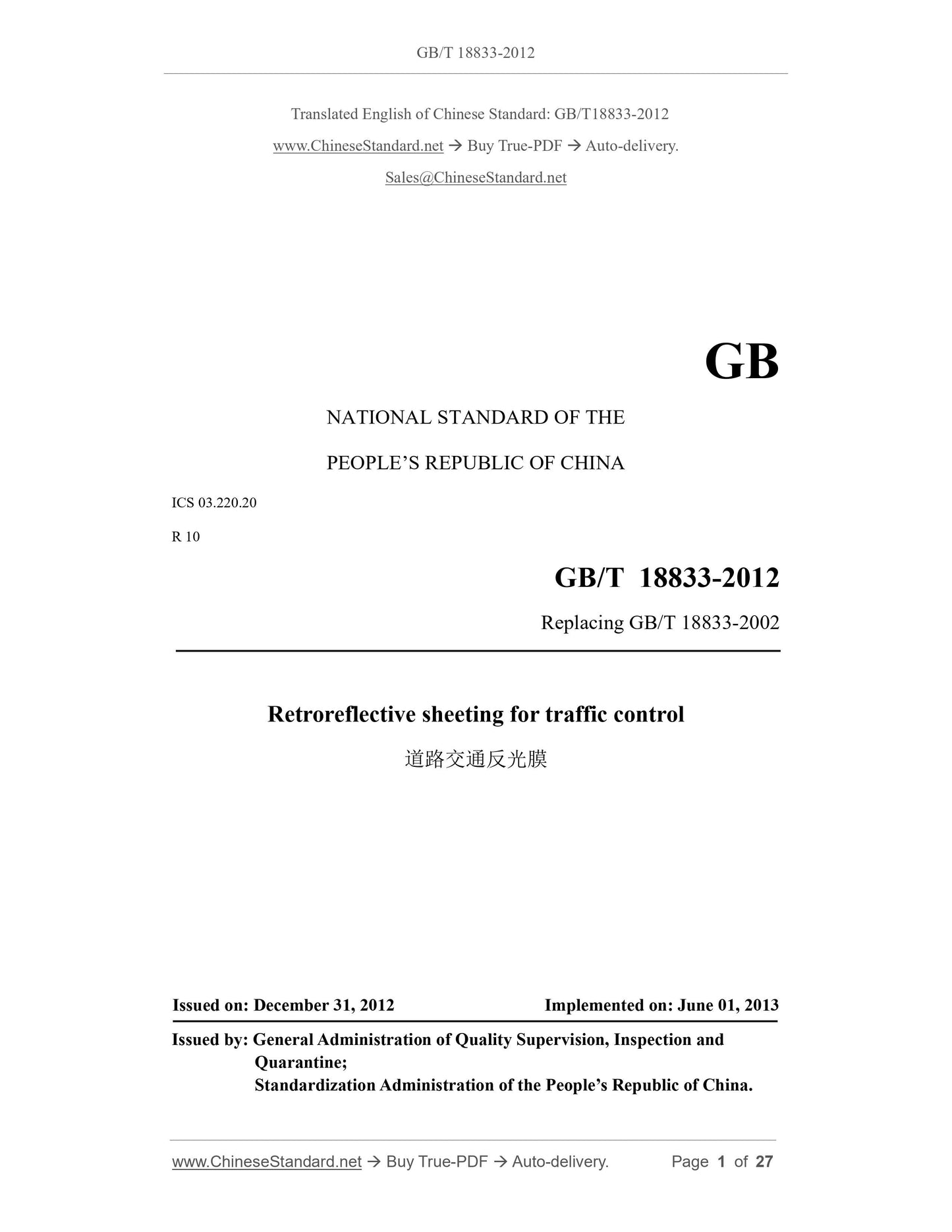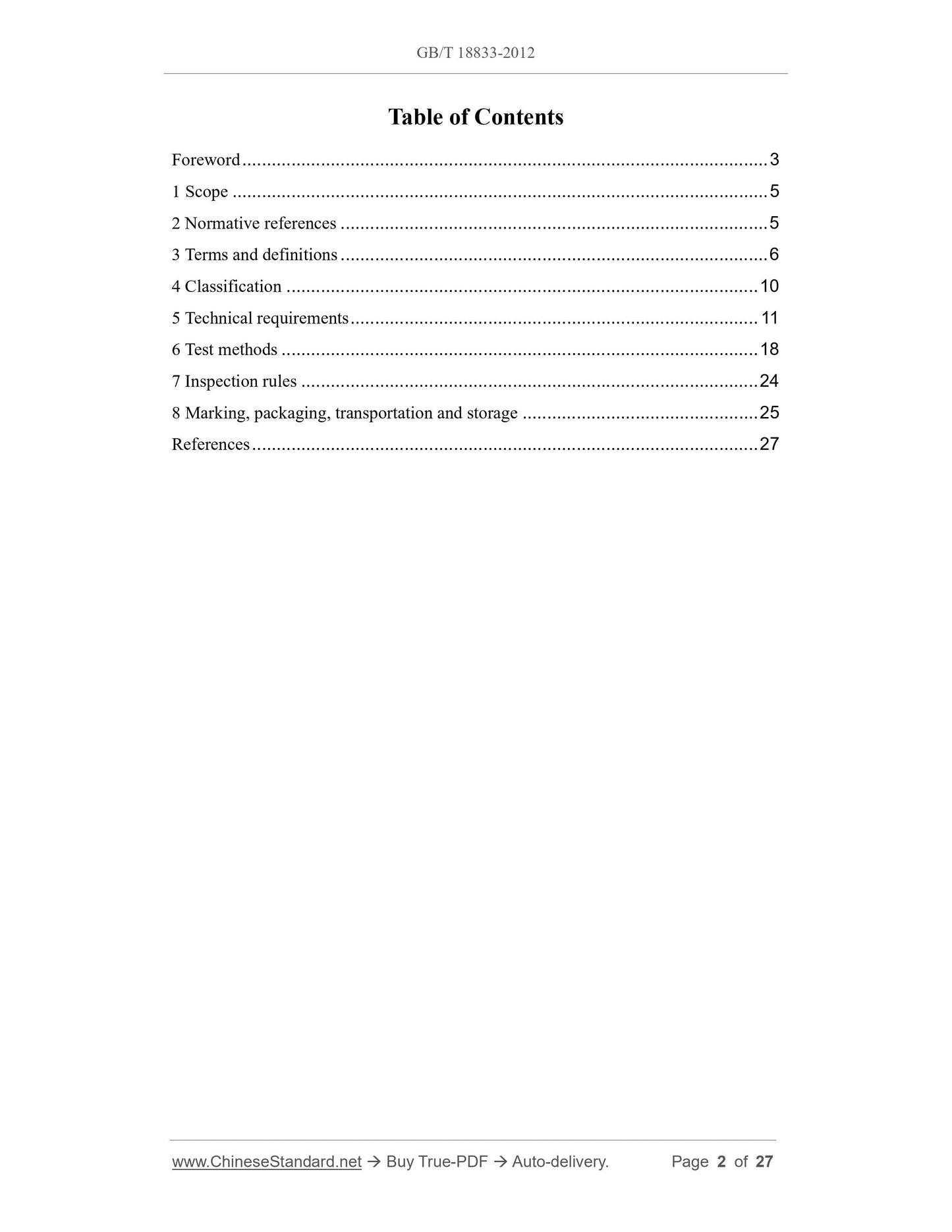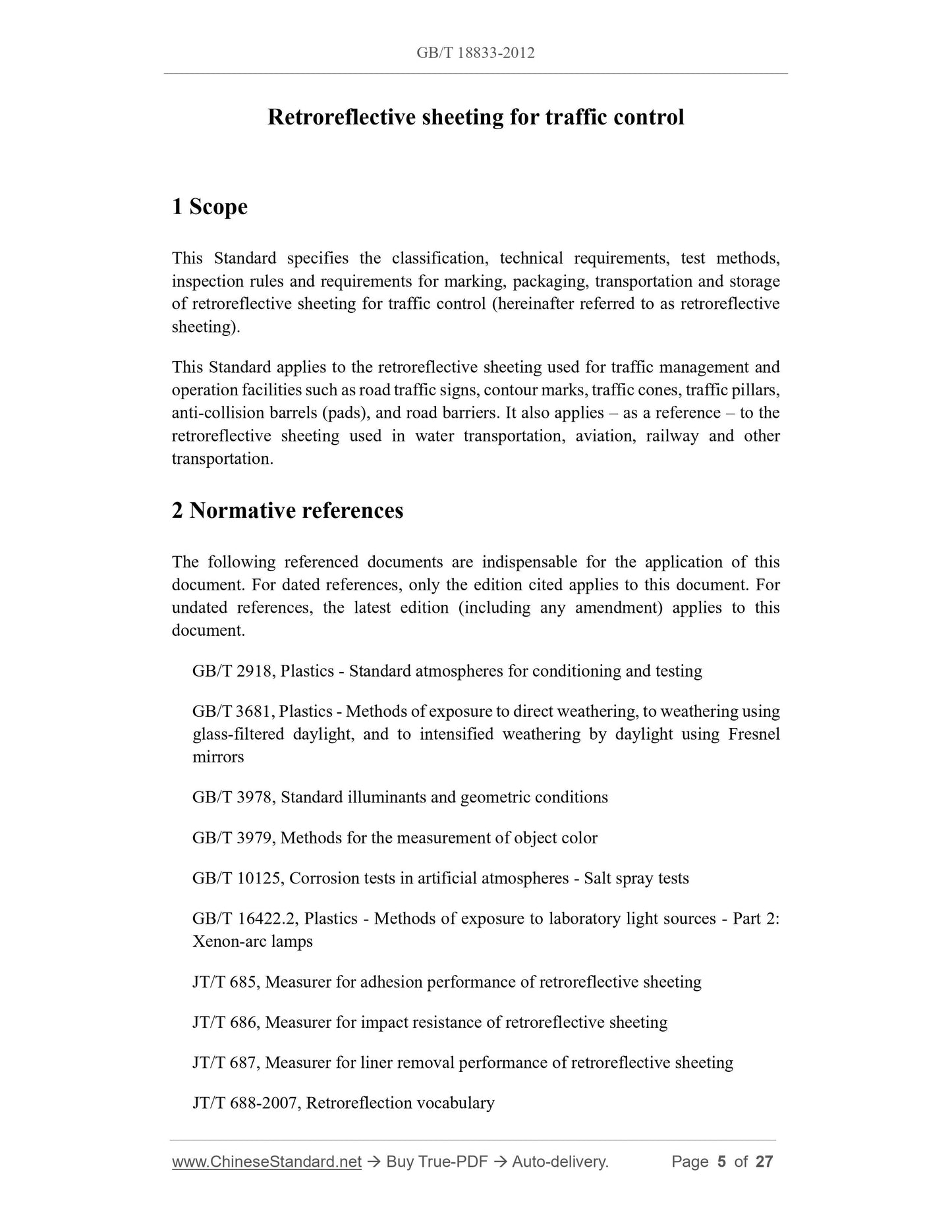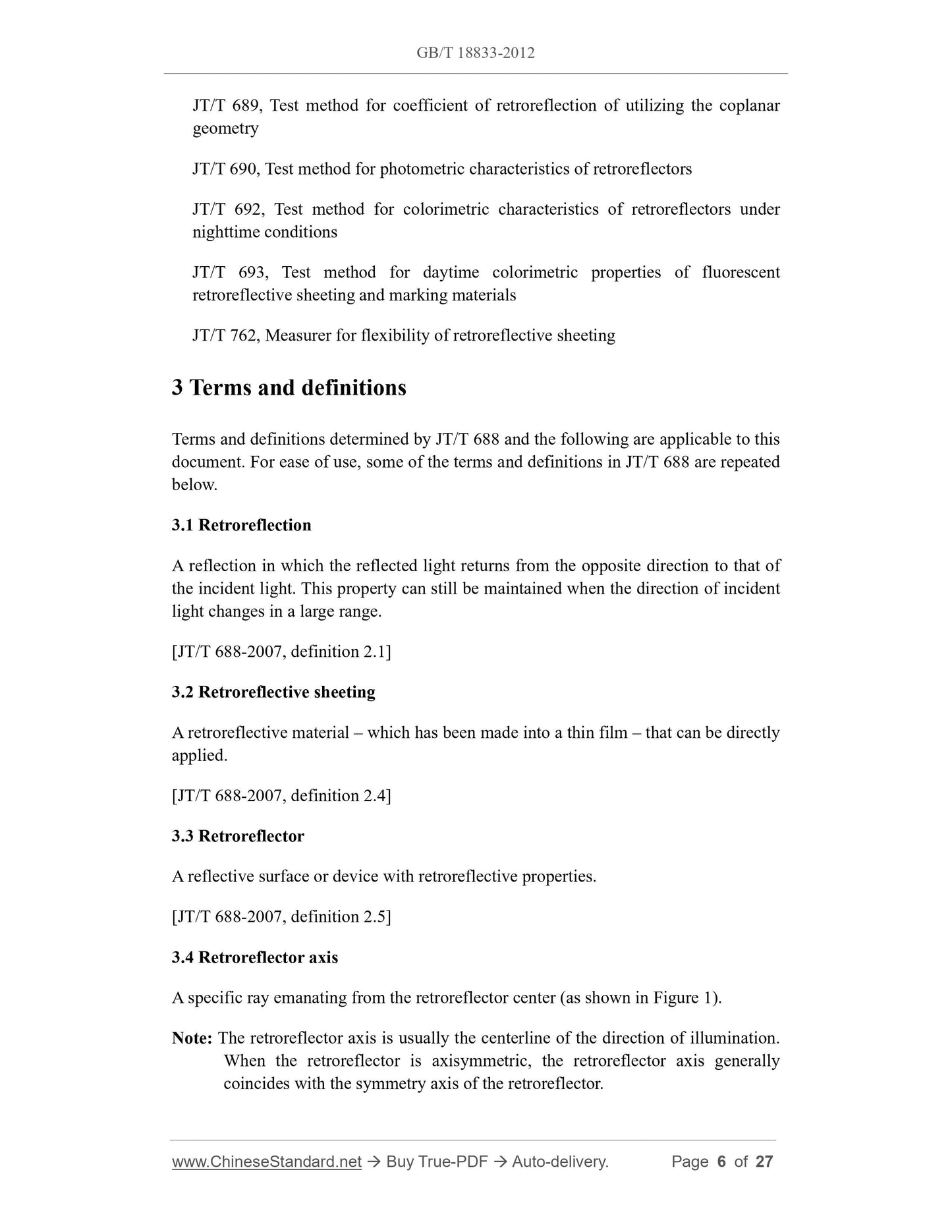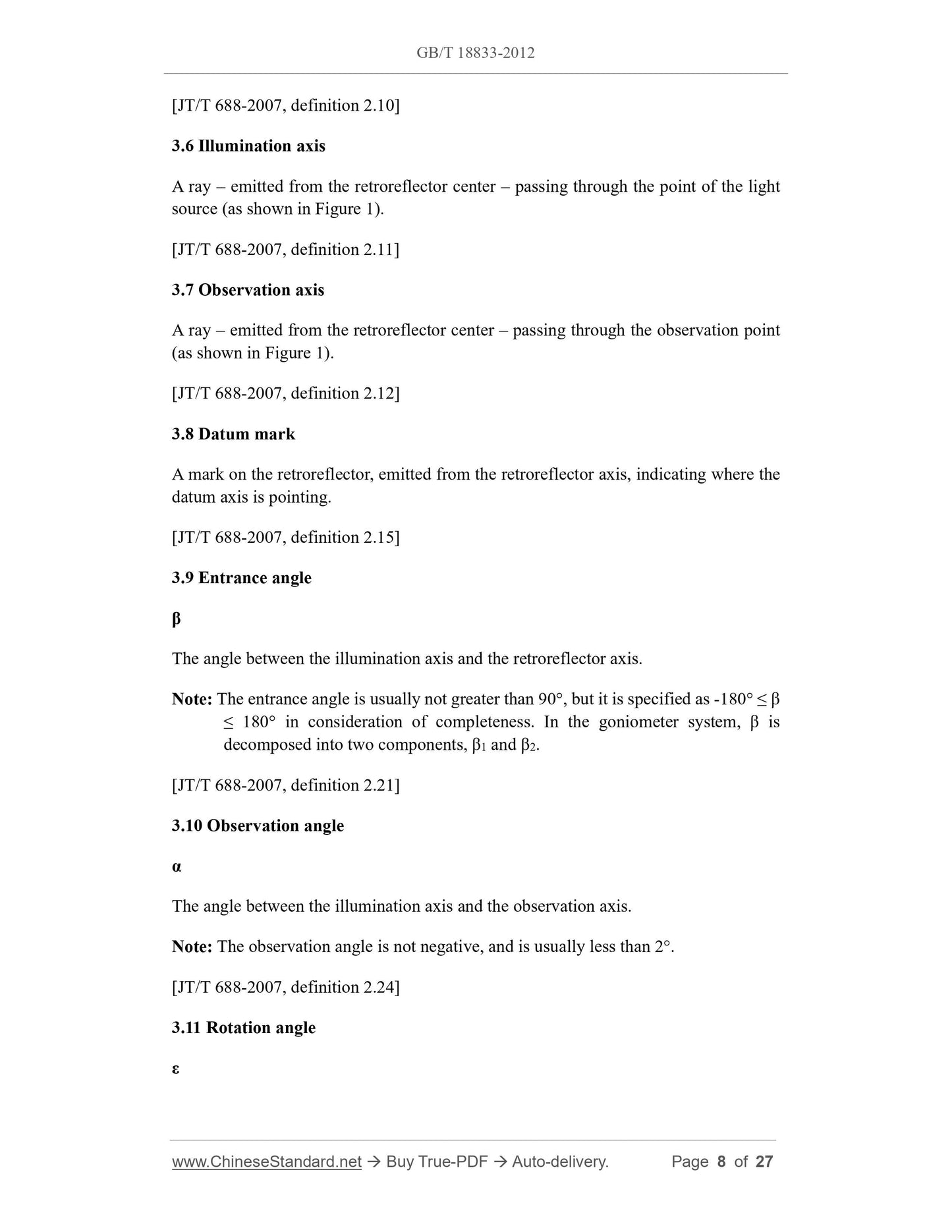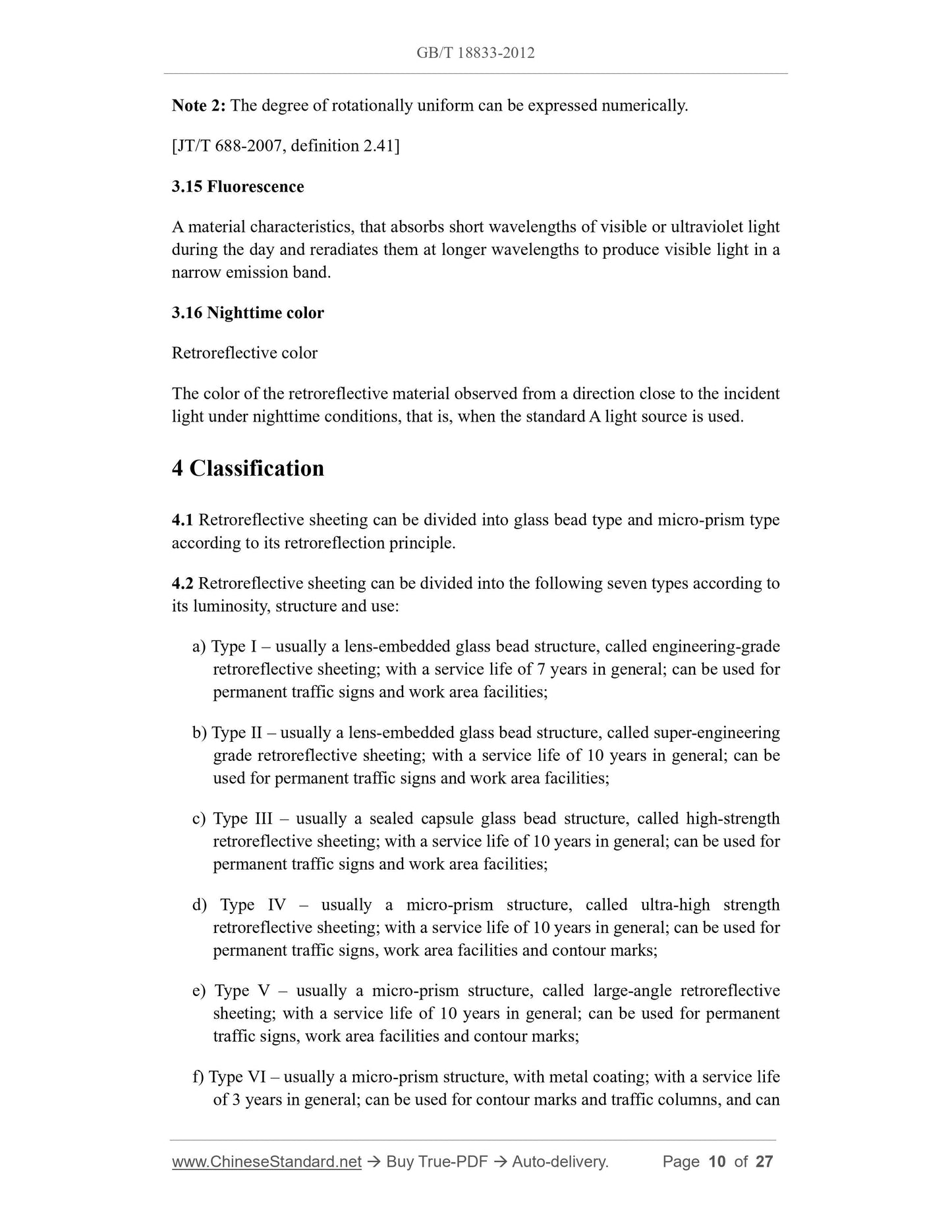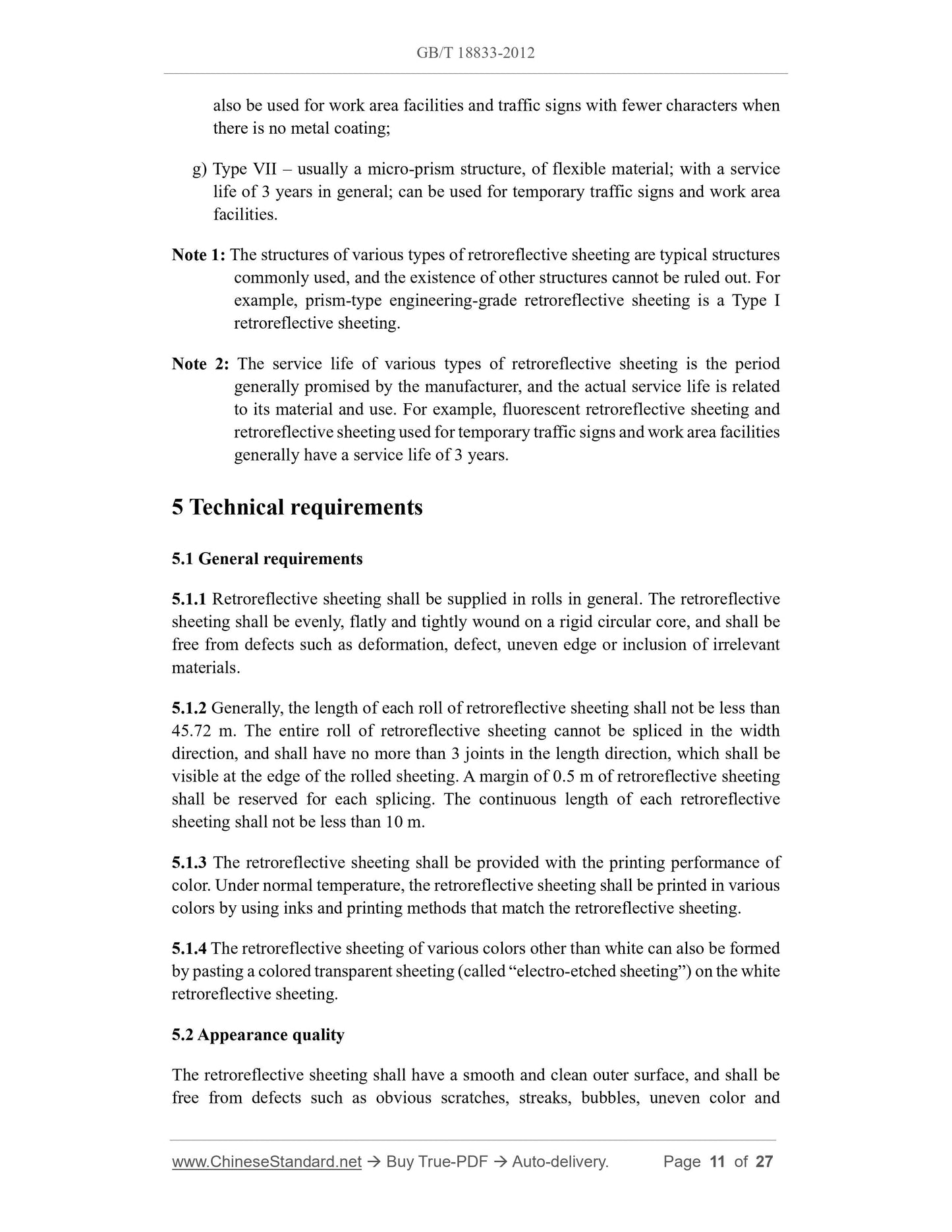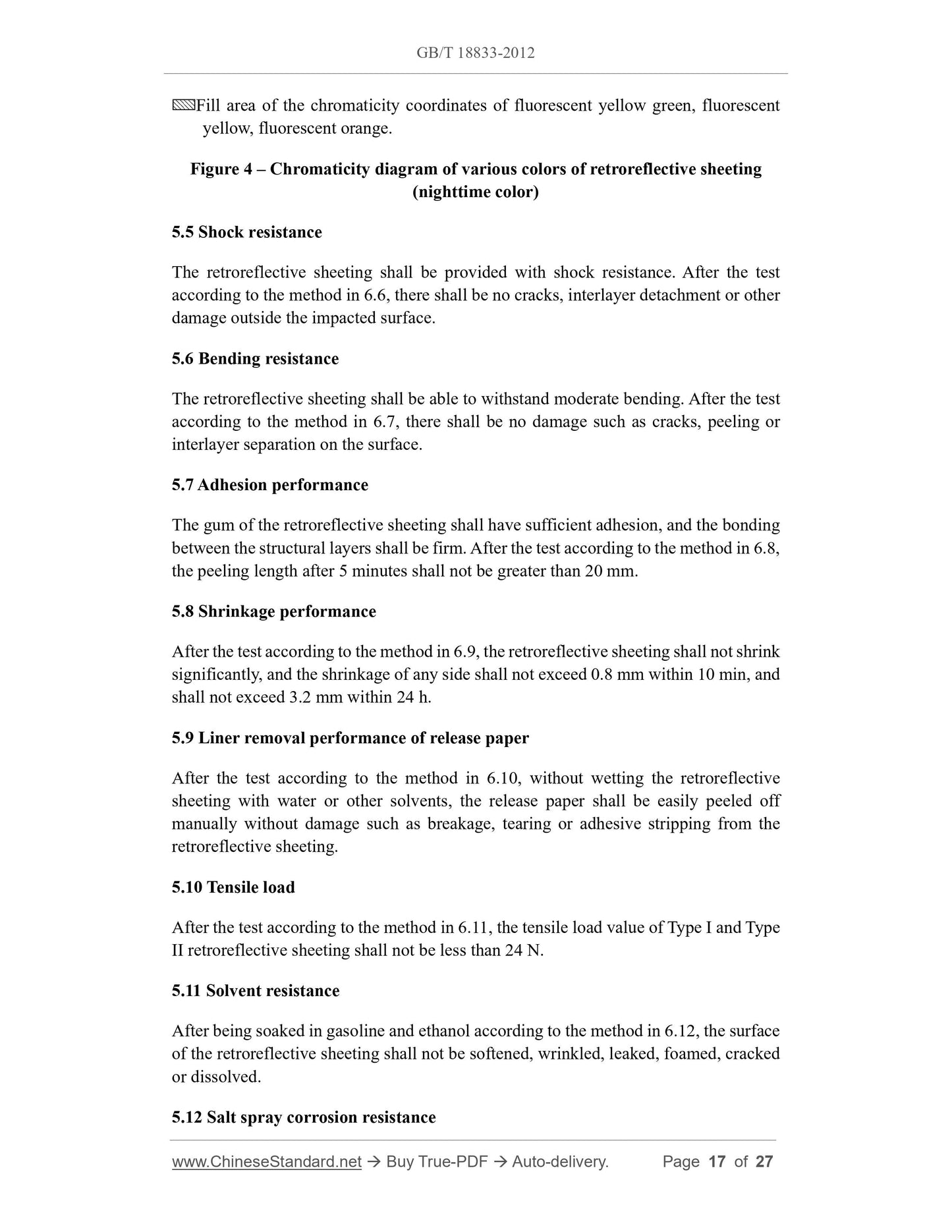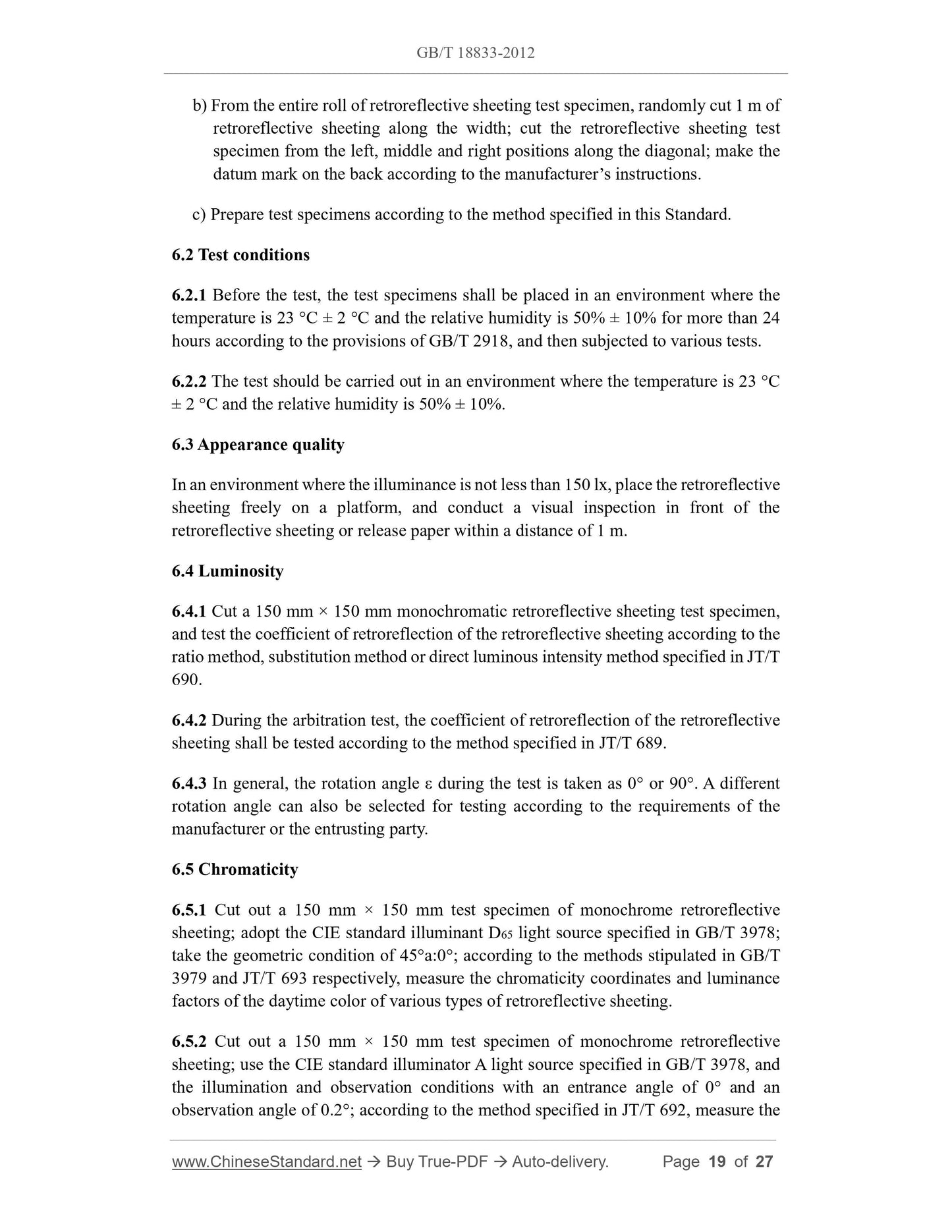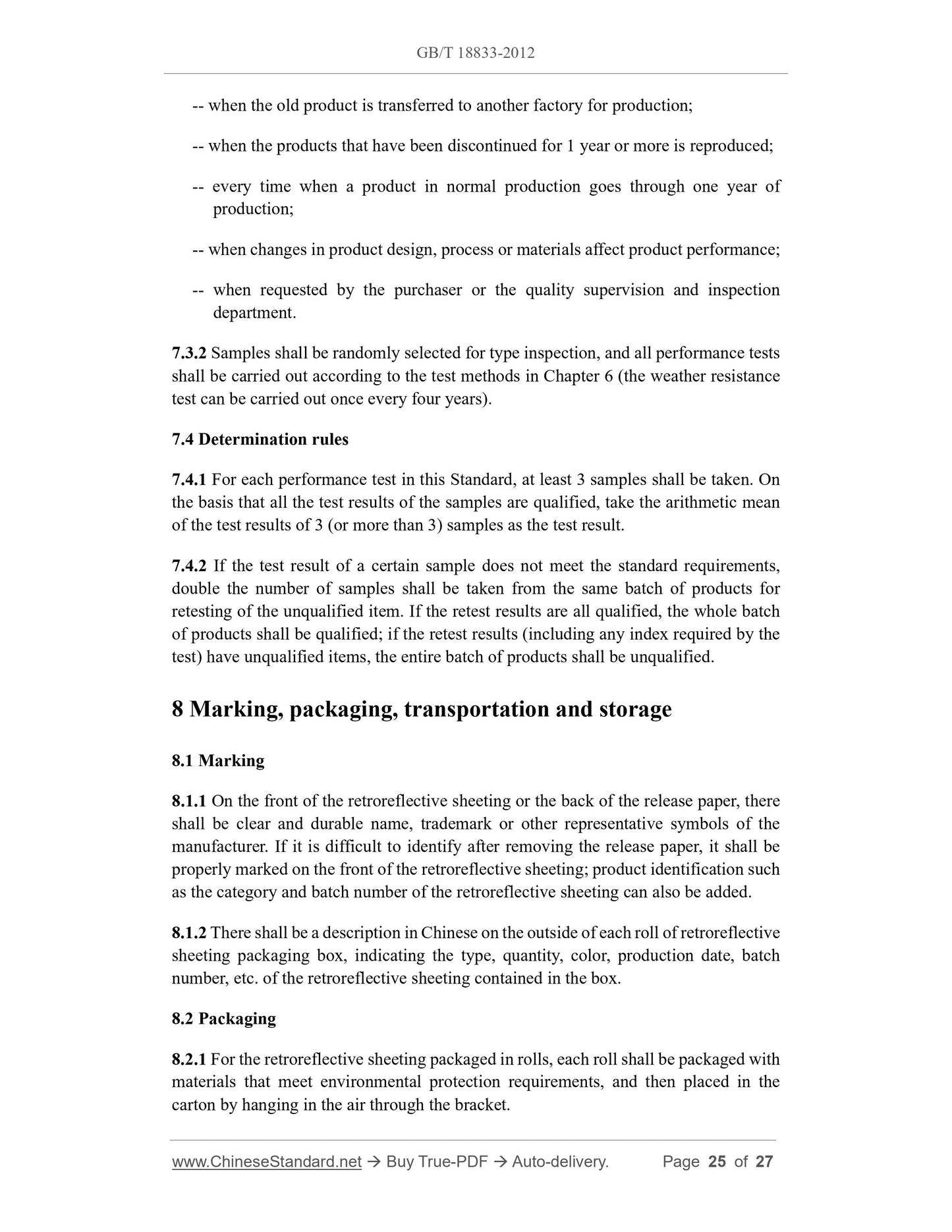1
/
of
10
PayPal, credit cards. Download editable-PDF and invoice in 1 second!
GB/T 18833-2012 English PDF (GBT18833-2012)
GB/T 18833-2012 English PDF (GBT18833-2012)
Regular price
$335.00 USD
Regular price
Sale price
$335.00 USD
Unit price
/
per
Shipping calculated at checkout.
Couldn't load pickup availability
Delivery: 3 seconds. Download true-PDF + Invoice.
Get QUOTATION in 1-minute: Click GB/T 18833-2012
Historical versions: GB/T 18833-2012
Preview True-PDF (Reload/Scroll if blank)
GB/T 18833-2012: Retroreflective sheeting for traffic control
GB/T 18833-2012
GB
NATIONAL STANDARD OF THE
PEOPLE’S REPUBLIC OF CHINA
ICS 03.220.20
R 10
Replacing GB/T 18833-2002
Retroreflective sheeting for traffic control
ISSUED ON: DECEMBER 31, 2012
IMPLEMENTED ON: JUNE 01, 2013
Issued by: General Administration of Quality Supervision, Inspection and
Quarantine;
Standardization Administration of the People’s Republic of China.
Table of Contents
Foreword ... 3
1 Scope ... 5
2 Normative references ... 5
3 Terms and definitions ... 6
4 Classification ... 10
5 Technical requirements ... 11
6 Test methods ... 18
7 Inspection rules ... 24
8 Marking, packaging, transportation and storage ... 25
References ... 27
Retroreflective sheeting for traffic control
1 Scope
This Standard specifies the classification, technical requirements, test methods,
inspection rules and requirements for marking, packaging, transportation and storage
of retroreflective sheeting for traffic control (hereinafter referred to as retroreflective
sheeting).
This Standard applies to the retroreflective sheeting used for traffic management and
operation facilities such as road traffic signs, contour marks, traffic cones, traffic pillars,
anti-collision barrels (pads), and road barriers. It also applies – as a reference – to the
retroreflective sheeting used in water transportation, aviation, railway and other
transportation.
2 Normative references
The following referenced documents are indispensable for the application of this
document. For dated references, only the edition cited applies to this document. For
undated references, the latest edition (including any amendment) applies to this
document.
GB/T 2918, Plastics - Standard atmospheres for conditioning and testing
GB/T 3681, Plastics - Methods of exposure to direct weathering, to weathering using
glass-filtered daylight, and to intensified weathering by daylight using Fresnel
mirrors
GB/T 3978, Standard illuminants and geometric conditions
GB/T 3979, Methods for the measurement of object color
GB/T 10125, Corrosion tests in artificial atmospheres - Salt spray tests
GB/T 16422.2, Plastics - Methods of exposure to laboratory light sources - Part 2:
Xenon-arc lamps
JT/T 685, Measurer for adhesion performance of retroreflective sheeting
JT/T 686, Measurer for impact resistance of retroreflective sheeting
JT/T 687, Measurer for liner removal performance of retroreflective sheeting
JT/T 688-2007, Retroreflection vocabulary
JT/T 689, Test method for coefficient of retroreflection of utilizing the coplanar
geometry
JT/T 690, Test method for photometric characteristics of retroreflectors
JT/T 692, Test method for colorimetric characteristics of retroreflectors under
nighttime conditions
JT/T 693, Test method for daytime colorimetric properties of fluorescent
retroreflective sheeting and marking materials
JT/T 762, Measurer for flexibility of retroreflective sheeting
3 Terms and definitions
Terms and definitions determined by JT/T 688 and the following are applicable to this
document. For ease of use, some of the terms and definitions in JT/T 688 are repeated
below.
3.1 Retroreflection
A reflection in which the reflected light returns from the opposite direction to that of
the incident light. This property can still be maintained when the direction of incident
light changes in a large range.
[JT/T 688-2007, definition 2.1]
3.2 Retroreflective sheeting
A retroreflective material – which has been made into a thin film – that can be directly
applied.
[JT/T 688-2007, definition 2.4]
3.3 Retroreflector
A reflective surface or device with retroreflective properties.
[JT/T 688-2007, definition 2.5]
3.4 Retroreflector axis
A specific ray emanating from the retroreflector center (as shown in Figure 1).
Note: The retroreflector axis is usually the centerline of the direction of illumination.
When the retroreflector is axisymmetric, the retroreflector axis generally
coincides with the symmetry axis of the retroreflector.
[JT/T 688-2007, definition 2.10]
3.6 Illumination axis
A ray – emitted from the retroreflector center – passing through the point of the light
source (as shown in Figure 1).
[JT/T 688-2007, definition 2.11]
3.7 Observation axis
A ray – emitted from the retroreflector center – passing through the observation point
(as shown in Figure 1).
[JT/T 688-2007, definition 2.12]
3.8 Datum mark
A mark on the retroreflector, emitted from the retroreflector axis, indicating where the
datum axis is pointing.
[JT/T 688-2007, definition 2.15]
3.9 Entrance angle
The angle between the illumination axis and the retroreflector axis.
Note: The entrance angle is usually not greater than 90°, but it is specified as -180° ≤ β
≤ 180° in consideration of completeness. In the goniometer system, β is
decomposed into two components, β1 and β2.
[JT/T 688-2007, definition 2.21]
3.10 Observation angle
The angle between the illumination axis and the observation axis.
Note: The observation angle is not negative, and is usually less than 2°.
[JT/T 688-2007, definition 2.24]
3.11 Rotation angle
Note 2: The degree of rotationally uniform can be expressed numerically.
[JT/T 688-2007, definition 2.41]
3.15 Fluorescence
A material characteristics, that absorbs short wavelengths of visible or ultraviolet light
during the day and reradiates them at longer wavelengths to produce visible light in a
narrow emission band.
3.16 Nighttime color
Retroreflective color
The color of the retroreflective material observed from a direction close to the incident
light under nighttime conditions, that is, when the standard A light source is used.
4 Classification
4.1 Retroreflective sheeting can be divided into glass bead type and micro-prism type
according to its retroreflection principle.
4.2 Retroreflective sheeting can be divided into the following seven types according to
its luminosity, structure and use:
a) Type I – usually a lens-embedded glass bead structure, called engineering-grade
retroreflective sheeting; with a service life of 7 years in general; can be used for
permanent traffic signs and work area facilities;
b) Type II – usually a lens-embedded glass bead structure, called super-engineering
grade retroreflective sheeting; with a service life of 10 years in general; can be
used for permanent traffic signs and work area facilities;
c) Type III – usually a sealed capsule glass bead structure, called high-strength
retroreflective sheeting; with a service life of 10 years in general; can be used for
permanent traffic signs and work area facilities;
d) Type IV – usually a micro-prism structure, called ultra-high strength
retroreflective sheeting; with a service life of 10 years in general; can be used for
permanent traffic signs, work area facilities and contour marks;
e) Type V – usually a micro-prism structure, called large-angle retroreflective
sheeting; with a service life of 10 years in general; can be used for permanent
traffic signs, work area facilities and contour marks;
f) Type VI – usually a micro-prism structure, with metal coating; with a service life
of 3 years in general; can be used for contour marks and traffic columns, and can
also be used for work area facilities and traffic signs with fewer characters when
there is no metal coating;
g) Type VII – usually a micro-prism structure, of flexible material; with a service
life of 3 y...
Get QUOTATION in 1-minute: Click GB/T 18833-2012
Historical versions: GB/T 18833-2012
Preview True-PDF (Reload/Scroll if blank)
GB/T 18833-2012: Retroreflective sheeting for traffic control
GB/T 18833-2012
GB
NATIONAL STANDARD OF THE
PEOPLE’S REPUBLIC OF CHINA
ICS 03.220.20
R 10
Replacing GB/T 18833-2002
Retroreflective sheeting for traffic control
ISSUED ON: DECEMBER 31, 2012
IMPLEMENTED ON: JUNE 01, 2013
Issued by: General Administration of Quality Supervision, Inspection and
Quarantine;
Standardization Administration of the People’s Republic of China.
Table of Contents
Foreword ... 3
1 Scope ... 5
2 Normative references ... 5
3 Terms and definitions ... 6
4 Classification ... 10
5 Technical requirements ... 11
6 Test methods ... 18
7 Inspection rules ... 24
8 Marking, packaging, transportation and storage ... 25
References ... 27
Retroreflective sheeting for traffic control
1 Scope
This Standard specifies the classification, technical requirements, test methods,
inspection rules and requirements for marking, packaging, transportation and storage
of retroreflective sheeting for traffic control (hereinafter referred to as retroreflective
sheeting).
This Standard applies to the retroreflective sheeting used for traffic management and
operation facilities such as road traffic signs, contour marks, traffic cones, traffic pillars,
anti-collision barrels (pads), and road barriers. It also applies – as a reference – to the
retroreflective sheeting used in water transportation, aviation, railway and other
transportation.
2 Normative references
The following referenced documents are indispensable for the application of this
document. For dated references, only the edition cited applies to this document. For
undated references, the latest edition (including any amendment) applies to this
document.
GB/T 2918, Plastics - Standard atmospheres for conditioning and testing
GB/T 3681, Plastics - Methods of exposure to direct weathering, to weathering using
glass-filtered daylight, and to intensified weathering by daylight using Fresnel
mirrors
GB/T 3978, Standard illuminants and geometric conditions
GB/T 3979, Methods for the measurement of object color
GB/T 10125, Corrosion tests in artificial atmospheres - Salt spray tests
GB/T 16422.2, Plastics - Methods of exposure to laboratory light sources - Part 2:
Xenon-arc lamps
JT/T 685, Measurer for adhesion performance of retroreflective sheeting
JT/T 686, Measurer for impact resistance of retroreflective sheeting
JT/T 687, Measurer for liner removal performance of retroreflective sheeting
JT/T 688-2007, Retroreflection vocabulary
JT/T 689, Test method for coefficient of retroreflection of utilizing the coplanar
geometry
JT/T 690, Test method for photometric characteristics of retroreflectors
JT/T 692, Test method for colorimetric characteristics of retroreflectors under
nighttime conditions
JT/T 693, Test method for daytime colorimetric properties of fluorescent
retroreflective sheeting and marking materials
JT/T 762, Measurer for flexibility of retroreflective sheeting
3 Terms and definitions
Terms and definitions determined by JT/T 688 and the following are applicable to this
document. For ease of use, some of the terms and definitions in JT/T 688 are repeated
below.
3.1 Retroreflection
A reflection in which the reflected light returns from the opposite direction to that of
the incident light. This property can still be maintained when the direction of incident
light changes in a large range.
[JT/T 688-2007, definition 2.1]
3.2 Retroreflective sheeting
A retroreflective material – which has been made into a thin film – that can be directly
applied.
[JT/T 688-2007, definition 2.4]
3.3 Retroreflector
A reflective surface or device with retroreflective properties.
[JT/T 688-2007, definition 2.5]
3.4 Retroreflector axis
A specific ray emanating from the retroreflector center (as shown in Figure 1).
Note: The retroreflector axis is usually the centerline of the direction of illumination.
When the retroreflector is axisymmetric, the retroreflector axis generally
coincides with the symmetry axis of the retroreflector.
[JT/T 688-2007, definition 2.10]
3.6 Illumination axis
A ray – emitted from the retroreflector center – passing through the point of the light
source (as shown in Figure 1).
[JT/T 688-2007, definition 2.11]
3.7 Observation axis
A ray – emitted from the retroreflector center – passing through the observation point
(as shown in Figure 1).
[JT/T 688-2007, definition 2.12]
3.8 Datum mark
A mark on the retroreflector, emitted from the retroreflector axis, indicating where the
datum axis is pointing.
[JT/T 688-2007, definition 2.15]
3.9 Entrance angle
The angle between the illumination axis and the retroreflector axis.
Note: The entrance angle is usually not greater than 90°, but it is specified as -180° ≤ β
≤ 180° in consideration of completeness. In the goniometer system, β is
decomposed into two components, β1 and β2.
[JT/T 688-2007, definition 2.21]
3.10 Observation angle
The angle between the illumination axis and the observation axis.
Note: The observation angle is not negative, and is usually less than 2°.
[JT/T 688-2007, definition 2.24]
3.11 Rotation angle
Note 2: The degree of rotationally uniform can be expressed numerically.
[JT/T 688-2007, definition 2.41]
3.15 Fluorescence
A material characteristics, that absorbs short wavelengths of visible or ultraviolet light
during the day and reradiates them at longer wavelengths to produce visible light in a
narrow emission band.
3.16 Nighttime color
Retroreflective color
The color of the retroreflective material observed from a direction close to the incident
light under nighttime conditions, that is, when the standard A light source is used.
4 Classification
4.1 Retroreflective sheeting can be divided into glass bead type and micro-prism type
according to its retroreflection principle.
4.2 Retroreflective sheeting can be divided into the following seven types according to
its luminosity, structure and use:
a) Type I – usually a lens-embedded glass bead structure, called engineering-grade
retroreflective sheeting; with a service life of 7 years in general; can be used for
permanent traffic signs and work area facilities;
b) Type II – usually a lens-embedded glass bead structure, called super-engineering
grade retroreflective sheeting; with a service life of 10 years in general; can be
used for permanent traffic signs and work area facilities;
c) Type III – usually a sealed capsule glass bead structure, called high-strength
retroreflective sheeting; with a service life of 10 years in general; can be used for
permanent traffic signs and work area facilities;
d) Type IV – usually a micro-prism structure, called ultra-high strength
retroreflective sheeting; with a service life of 10 years in general; can be used for
permanent traffic signs, work area facilities and contour marks;
e) Type V – usually a micro-prism structure, called large-angle retroreflective
sheeting; with a service life of 10 years in general; can be used for permanent
traffic signs, work area facilities and contour marks;
f) Type VI – usually a micro-prism structure, with metal coating; with a service life
of 3 years in general; can be used for contour marks and traffic columns, and can
also be used for work area facilities and traffic signs with fewer characters when
there is no metal coating;
g) Type VII – usually a micro-prism structure, of flexible material; with a service
life of 3 y...
Share
